Comparative analysis and systematic mapping of the labial sensilla in the Nepomorpha (Heteroptera: Insecta)
- PMID: 23935421
- PMCID: PMC3713378
- DOI: 10.1155/2013/518034
Comparative analysis and systematic mapping of the labial sensilla in the Nepomorpha (Heteroptera: Insecta)
Abstract
The present study provides new data concerning the morphology and distribution of the labial sensilla of 55 species of 12 nepomorphan families (Heteroptera: Nepomorpha) using the scanning electron microscope. On the labial tip, three morphologically distinct types of chemosensilla have been identified: two types of papillae sensilla and one type of peg-in-pit sensilla. Twenty-one morphologically distinct types of the mechanosensilla as well as two types of the trichoid sensilla (contact-chemoreceptive sensillum) have been identified on all labial segments in representatives of subfamilies. In Nepomorpha, morphological ground plan of the labial sensory structures is represented by an apical sensory field with 10-13 pairs of papillae sensilla and the peg-in-pit ones placed more laterally; numerous trichoid sensilla are placed on the IV segment; the chaetica sensilla are present and placed in groups or rows distributed along the labium near the labial groove on the dorsal side, and also several chaetica sensilla are unevenly scattered on the surface of that segment; the cupola and peg sensilla are numerous and evenly scattered on the fourth labial segment; the prioprerecptive sensilla, one pair is positioned on the dorsal side and on the fourth segment of the labium. The new apomorphical characters have been established for the labial sensilla in the Nepomorpha.
Figures

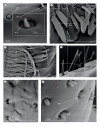
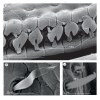


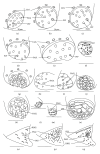
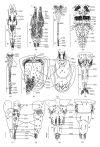
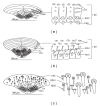
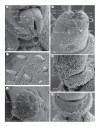
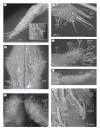
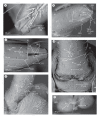
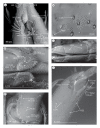
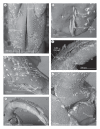
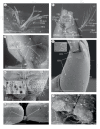
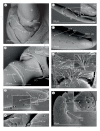
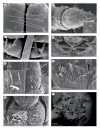
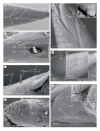

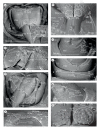
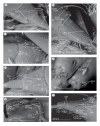
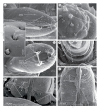
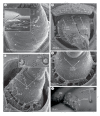
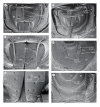
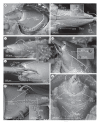

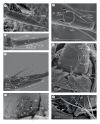
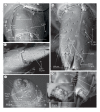
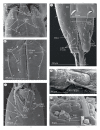
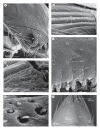
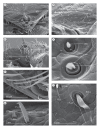
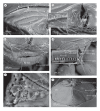
Similar articles
-
Phylogenetic signals from Nepomorpha (Insecta: Hemiptera: Heteroptera) mouthparts: stylets bundle, sense organs, and labial segments.ScientificWorldJournal. 2014;2014:237854. doi: 10.1155/2014/237854. Epub 2014 Apr 24. ScientificWorldJournal. 2014. PMID: 24883360 Free PMC article.
-
Deliberations on the external morphology and modification of the labial segments in the Nepomorpha (Heteroptera: Insecta) with notes on the phylogenetic characteristics.ScientificWorldJournal. 2013 Oct 31;2013:790343. doi: 10.1155/2013/790343. eCollection 2013. ScientificWorldJournal. 2013. PMID: 24294137 Free PMC article.
-
Morphology and distribution of the external labial sensilla in Fulgoromorpha (Insecta: Hemiptera).Zoomorphology. 2013 Mar;132(1):33-65. doi: 10.1007/s00435-012-0174-z. Epub 2012 Sep 30. Zoomorphology. 2013. PMID: 23420415 Free PMC article.
-
Morphological diversity of the labial sensilla of phytophagous and predatory Pentatomidae (Hemiptera: Heteroptera), with reference to their possible functions.Zootaxa. 2015 Nov 5;4039(2):359-72. doi: 10.11646/zootaxa.4039.2.9. Zootaxa. 2015. PMID: 26624484
-
The variability of antennal sensilla in Naucoridae (Heteroptera: Nepomorpha).Sci Rep. 2021 Oct 4;11(1):19651. doi: 10.1038/s41598-021-99067-5. Sci Rep. 2021. PMID: 34608210 Free PMC article.
Cited by
-
Phylogenetic signals from Nepomorpha (Insecta: Hemiptera: Heteroptera) mouthparts: stylets bundle, sense organs, and labial segments.ScientificWorldJournal. 2014;2014:237854. doi: 10.1155/2014/237854. Epub 2014 Apr 24. ScientificWorldJournal. 2014. PMID: 24883360 Free PMC article.
-
Achiasmate male meiosis in two Cymatia species (Hemiptera, Heteroptera, Corixidae).Zookeys. 2015 Nov 19;(538):95-104. doi: 10.3897/zookeys.538.6722. eCollection 2015. Zookeys. 2015. PMID: 26807038 Free PMC article.
-
Ultra-Morphology and Mechanical Function of the Trichoideum Sensillum in Nabis rugosus (Linnaeus, 1758) (Insecta: Heteroptera: Cimicomorpha).Insects. 2022 Sep 1;13(9):799. doi: 10.3390/insects13090799. Insects. 2022. PMID: 36135500 Free PMC article.
-
Labial Sensory Organs of Two Leptoglossus Species (Hemiptera: Coreidae): Their Morphology and Supposed Function.Insects. 2022 Dec 28;14(1):30. doi: 10.3390/insects14010030. Insects. 2022. PMID: 36661958 Free PMC article.
-
Deliberations on the external morphology and modification of the labial segments in the Nepomorpha (Heteroptera: Insecta) with notes on the phylogenetic characteristics.ScientificWorldJournal. 2013 Oct 31;2013:790343. doi: 10.1155/2013/790343. eCollection 2013. ScientificWorldJournal. 2013. PMID: 24294137 Free PMC article.
References
-
- Cobben RH. Evolutionary Trends in Heteroptera—Part 2: Mouthpart-Structures and Feeding Strategies. Meded, Landbou-whogeschool Wageningen; 1978.
-
- Popov YA. Historical development of the hemipterous infraorder Nepomorpha. Trudy Paleontological Institute Academy of Science, Nauk, USSR. 1971;129:1–228. (Rus).
-
- Backus EA. Anatomical and sensory mechanisms of leafhopper and planthopper feeding behavior. In: Nault LR, Rodriguez JG, editors. The Leafhoppers and Planthoppers. New York, NY, USA: John Wiley & Sons; 1985. pp. 163–194.
-
- Chapman RF. Mechanoreception. Chemoreception. In: Chapman RF, editor. The Insects, Structure and Function. 4th edition. Cambridge, UK: Cambridge University Press; 1998. pp. 610–653.
-
- Miles PW. The stylet movements of a plant-sucking bug, Oncopeltus fasciatus Dall. Heteroptera: Lygaeidae. Proceedings of the Royal Entomological Society of London. 1958;33:15–20.
Publication types
MeSH terms
LinkOut - more resources
Full Text Sources
Other Literature Sources

